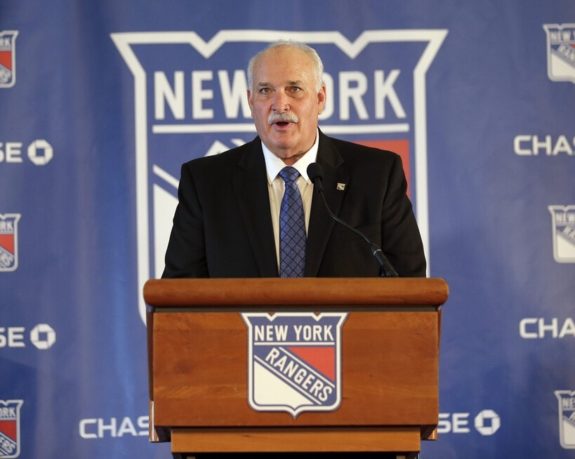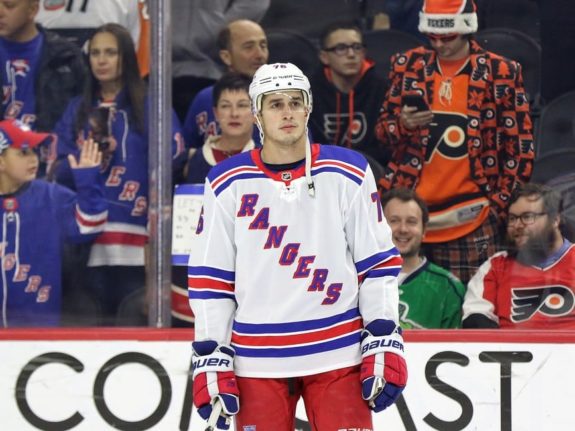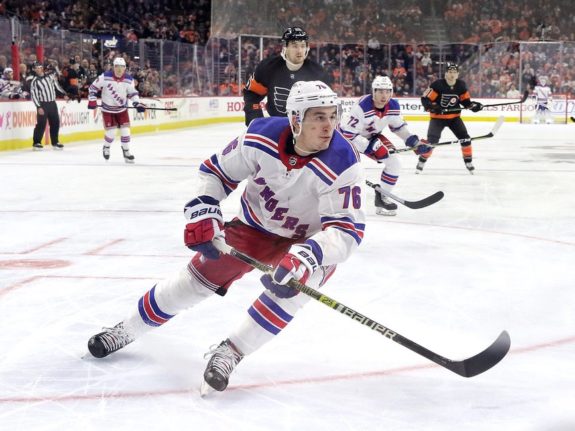2020 NHL trade deadline day was a truly wild one for the New York Rangers – it was one of the club’s most eventful days in a long time, especially considering the head-spinning Monday contained only one trade by the Blueshirts.
That move occurred on a day in which team president John Davidson started his address to the media by announcing that two of the team’s young Russian stars had avoided disaster in a serious car crash, just before he got down to discussing the Rangers and star winger Chris Kreider agreeing to a lucrative and somewhat unexpected contract extension. The one swap, though, which involved defenseman Brady Skjei going to the Carolina Hurricanes, said as much about management’s competence in building up the team as did the decision to commit long-term to Kreider.
Related: New York Rangers’ Goaltending Situation
The concern in Davidson’s voice was evident at his late-morning news conference as he talked about the Sunday evening car accident in which rising young goaltender Igor Shesterkin suffered a non-displaced rib fracture that should keep him out at least a couple of weeks, and winger Pavel Buchnevich avoided injury. Davidson pivoted nimbly to muted excitement over what many thought would be the singular story of the day regarding the Rangers – the inking of Kreider to a seven-year, $45.5 million pact well before the deadline, dashing numerous playoff contenders’ hopes of acquiring the skilled power forward for a postseason run.

Yet the somewhat remarkable unloading of Skjei’s ill-advised contract – in exchange for a first-round pick, no less – hours later could in some ways prove to be as important as the decision to keep Kreider on Broadway for the majority of his career.
The benefits of subtracting Skjei from the payroll and roster are numerous. The Rangers’ rebuild moving forward depends on their ability to hold onto some of the young assets they’ve spent time developing, and adding $5.25 million of cap space for each of the next four seasons will be invaluable. General manager Jeff Gorton, the architect of Monday’s two masterstrokes, should have the space to re-sign restricted free agent defenseman Tony DeAngelo after this season, and he should also be able to re-up center Ryan Strome, forward Brendan Lemieux, and goaltender Alexander Georgiev if he chooses as well.
Related: Chris Kreider’s Contract Pros & Cons
Perhaps the club can even keep heart-and-soul winger Jesper Fast, given the projected $17 million or so in cap space that the Blueshirts should possess this summer – a number that could rise if the club decides to move on from star goalie Henrik Lundqvist.
Skjei’s Departure Opens Spot for Defense Prospects
Without moving Skjei, it’s likely Gorton would have had to sacrifice at least one and possibly two players from the above group to make the numbers work. The additional space should also help the Rangers re-sign some of their talented youngsters who are due to come off entry-level deals in the next few seasons – such as Shesterkin, Ryan Lindgren, Filip Chytil, Adam Fox, Kaapo Kakko and Brett Howden.
Nearly as important, Skjei leaving opens room and flexibility on the left side for more of the organization’s young defense prospects to make the team. Libor Hajek could be recalled after a stint in Hartford to rediscover his game following an injury, or the promising Yegor Rykov could get the chance to take some of Skjei’s minutes.

Next season, right-hander DeAngelo could move to the left side, where he’s comfortable, creating an opening for promising right-side prospect Nils Lundqvist. Plus, veteran Marc Staal’s contract expires after next season, which might allow for K’Andre Miller to make his much-anticipated way to Broadway. In short order, there will be two spots on defense for the best of the Rangers’ impressive group of young blueliners to take the opportunity and run with it.
That chance to make the roster work better for the long term presented itself in part because Gorton, Davidson, and Co. were willing to admit to a mistake – and rather than double down for the purpose of saving face, take steps to correct it.
“You have to keep your eye on what the big picture is,” Davidson said. “You have to make decisions with that in mind. We have a plan, and that’s what we are trying to implement.”
The front office jumped the gun in getting Skjei, their 2012 first-round draft pick, under contract long term after the 2017-18 season, foreseeing a future cornerstone on the backline. Management chose to ignore that Skjei was coming off a disconcerting second season in which he posted a minus-27 rating and focus on 2016-17 when he looked like the prototypical modern NHL defender who boasted size, skating ability, and some offensive potential.

Team brass was perhaps emboldened by the successful pre-emptive long-term signing of top center Mika Zibanejad the previous summer, as Zibanejad rewarded the club with what was then his best season in 2017-18 and has been one of the NHL’s best bargains since – he’s under contract at $5.35 million per for two more seasons.
The similar roll of the dice with Skjei, of course, didn’t work. He failed to validate the club’s decision to give him a six-year, $31.5 million contract in July 2018, struggling with consistency over the past two seasons and never resembling the confident player of that first full season.
Gorton Stayed Focused on Rebuild With Trade
What should evoke a level of comfort in Rangers fans is that Gorton saw the exact same problems they did in Skjei – and the GM refused to let ego get in the way when the chance to make the deal with the Hurricanes emerged just before Monday’s 3 P.M. deadline. Gorton acknowledged the error of the signing and moved effectively for the good of the organization, rather than keeping Skjei and hoping he eventually proved Gorton right. His course of action also wasn’t affected by any potential impact on Skjei’s defense partner Jacob Trouba, whose acquisition from the Winnipeg Jets last summer reunited the boyhood pals from Minnesota in Manhattan.
The trade could, of course, come back to bite the Rangers should the 25-year-old Skjei find his game with Carolina, which wanted him badly enough to make an already ugly cap situation worse. The return of a first-rounder, however, should help ease any seller’s remorse.
Also impressive about this deal is the fact that the club was able to remain focused and disciplined at the task at hand amid the chaos. The front office started the rollercoaster day finding out about the frightening incident involving Shesterkin and Buchnevich, experienced the euphoria of getting the Kreider deal done and then got thrown another curveball in the form of Lundqvist admitting after practice that he might actually be thinking about leaving the organization after the season (From ‘Henrik Lundqvist’s Strongest Indication He’s Thinking About His Rangers End, New York Post, 2/24/2020)

Yet the front office was still able to complete the Skjei trade with minutes to spare, refusing to be distracted from the job of pushing the Rangers’ build onward and upward. It’s a testimonial to a general manager and team president – and an organization as a whole – working in perfect harmony toward a singular goal and within a stated philosophy.
The trade of Skjei isn’t a step back for the Rangers’ reconstruction project, and it isn’t an unnecessary acceleration of the process either. It was the product of a management team unconcerned with the need to appear right about past moves, coupled with a laser focus on continuing the admirable work on restructuring their club’s roster for the long term. The Rangers should eventually be better off for it – and that should be all the validation Gorton and Davidson need.
Get the latest New York Rangers news, rumors, commentary and analysis